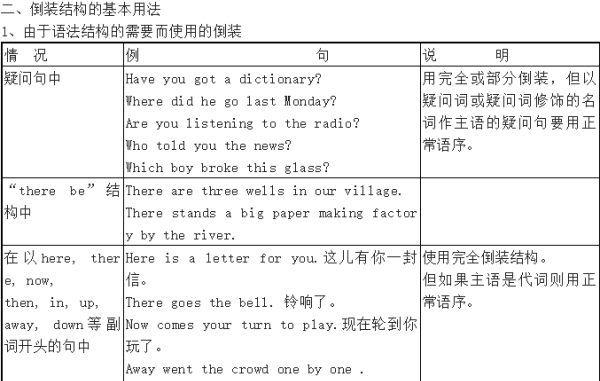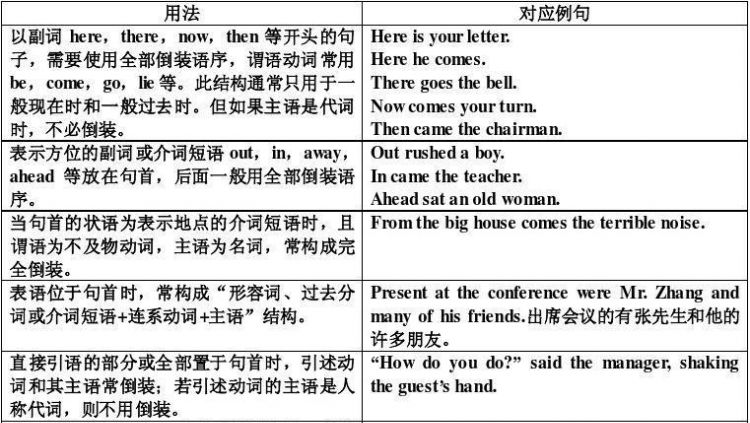本文目录
英语的倒装句结构是什么
倒装语序分为全部倒装和部分倒装,全部倒装结构是谓语动词提前至主语之前,部分倒装结构是助动词或情态动词提至主语之前,而谓语动词位置不变。
具有“地点”意义的副词、时间意义的副词,以及能表移动方向的副词放在句首,句子的主语是名词,谓语是连系动词或表示“位置移动”的单个不及物动词时,该动词放在主语前面。
具有“方位”意义的介词短语或副词短语在句中作状语或表语放在句首,谓语是连系动词be,以及表示“位于、存在”或“位置移动”的单个不及物动词时,该动词放在主语前面。

一、全部倒装:
谓语动词提前至主语之前为全部倒装。
1、当首句为方位或时间副词,谓语动词为go,come等时通常用全部倒装。
2、如果句首出现了地点状语,句子也可以进行全部倒装。
3、当句子中出现分词结构的时候,可以把现在分词或过去分词和地点状语联系在一起放在句首,把be动词留在中间当作谓语动词,主语放在后面。
二、部分倒装:
助动词或情态动词提至主语之前,谓语动词位置不变,即为部分倒装。
1、当句首状语为否定词或带有否定意义的词语时,这个句子就需要部分倒装。
2、当句首为only加状语的时候,这个句子需要部分倒装。
3、so.....that结构中的so位于句首时,常引起部分倒装。
4、句子开头的as处在第二个单词的位置上,表示虽然的意思时,用部分倒装。
5、常见的固定搭配结构中需要用倒装的情况。
英语倒装句的归纳总结
英语倒装句的详解
显而易见,英语的基本语序是“主语+谓语”,这种语序称为陈述句语序或自然语序(normal word order),如果把谓语的全部或一部分置于主语之前,就称为倒装语序(inverted word order),当谓语全部置于主语之前,称为全部倒装(full inversion);当谓语一部分(如助动词或情态动词)置于主语之前,称为部分倒装(partial inversion)。下面就让我为大家详解一下吧。

一、全部倒装
(一)there be句型
有时一些表示存在意义的不及物动词也可用于该句型,如:stand,lie,exist,live, remain,appear,come,happen,occur,rise等。
例句:Generally, there was a belief that the new nations should be sovereign and independent states, large enough to be economically viable and integrated by a common set of laws. (选自2007年Use of English)
分析:该句是复合句,其中a belief与that the new nations should be sovereign and independent states互为同位语关系,形容词短语large enough to be...作定语修饰states。
译文:他们普遍认为新生的国家是拥有主权和完全独立的国家,大到经济上可运行良好,并由一套共同法律让各个新的独立国家联合起来。
(二)表示方向、地点的状语等词置于句首
here, there, up, down, away, in, out, off等位于句首时,往往主谓倒装。
例句: Here is an example, which I heard at a nurses convention, of a story which works well because the audience all shared the same view of doctors.
(选自2002年Text 1)
分析: 该句是复合句,which I heard at a nurses convention和which works well共同修饰story。
译文: 举个例子,在一次护士大会上,我听到了一个效果很理想的幽默故事,因为听众都对医生持有相同的看法。
(三)作表语的形容词或分词置于句首
例句: Lying unconsciously under the tree was an old man aged 75.
分析: 该句是简单句,aged 75修饰an old man,作后置定语。
译文: 一位75岁高龄的老人躺在树下,已经不省人事。
二、部分倒装
(一)否定词或具有(半)否定意义的词或词组置于句首作状语
如:never, scarcely, hardly, rarely, seldom, little, no sooner...than, hardly...when,scarcely...when (before), not only, in no case (in no way, at no time, on no account, by no means,under no circumstances,in no respects)(决不,在任何情况下都不), no longer/no more (不再)。
例句: Television is one of the means by which these feelings are created and conveyed and perhaps never before has it served so much to connect different peoples and nations as in the recent events in Europe. (2005年第46题)
分析: 该句是复合句,and前是一复合句,定语从句by which...修饰the means,后一分句中never置于句首引起倒装。
译文: 电视是制造和表达这些情绪的方式之一,在加强不同民族和国家之间的联系方面,电视也许还从来没有像在欧洲事务中那样起过如此大的作用。
(二)only+副词/介词短语/状语从句(句首状语由only修饰)
例句: Only recently did linguists begin the serious study of languages that were very different from their own. (选自2004年Part B)
分析: 该句是复合句,that were very different from their own是修饰languages的定语从句。
译文: 直到最近,语言学家才开始认真研究与他们自己所掌握的完全不同的语言。
例句: Only gradually was the byproduct of the institution noted, and only more gradually still was this effect considered as a directive factor in the conduct of the institution.
(2009年第47题)
分析: 该句是由and连接的两个并列简单句,两个分句都是以only开头的倒装句,在前一分句中,主干部分是the byproduct of the institution was noted, only gradually修饰noted;在后一分句中,主干是this effect was considered..., 其中only more gradually修饰considered, as a directive factor作主语this effect的补足语,介词短语in the conduct of the institution作directive factor的后置定语。
译文: 人们只是逐渐地认识到制度这一副产品,而在运行这种制度的过程中,认识到这种效果具有指导性作用的时间则更加缓慢。
(三)条件从句中省略if
在虚拟语气中,条件从句if省略时,倒装到主语前的是助动词should,had和系动词were。
例句: Were the Times Co. to purchase another major media company, there is no doubt that it could dramatically transform a family run enterprise that still gets 90% of its revenues from newspapers. (1999年第13题)
分析: 该句是复合句,were the Times Co. to purchase是一省略if的倒装句,that it could dramatically...enterprise是doubt的同位语,而that still gets 90% of its revenues from newspapers是修饰enterprise的定语从句。
译文: 如果时代公司要收购另一家主流媒体公司的话,那仍旧靠报纸获得90%收入的家族式企业的模式肯定会遭到它大刀阔斧的改革。
例句: Had it not been for the timely investment from the general public, our company would not be so thriving as it is. (1998年第10题)
分析: 该句是复合句,had it not been...是一个省略if的倒装从句,整个句子表示混合式虚拟语气,主句表示与现在相反假设,从句表示与过去相反假设。
译文: 要不是公众及时投资,我们公司不会像现在这么繁荣。
(四)其他部分倒装情况
表示前面陈述的情况适合于后者,前面是肯定句,后面用so引导;前面是否定句,后面用neither或nor引导,省略倒装句中的助动词在时态和语态形式上与前面句子保持一致。。
例句: Americans no longer expect public figures, whether in speech or in writing, to command the English with skill and gift. Nor do they aspire to such command themselves. (选自2005年Text 4)
分析: 该句是由nor引导的并列句。whether in speech or in writing的完整形式是whether they are in speech or in writing,表示让步;介词短语with skill and gift在句中作状语修饰动词command。
译文: 美国人不再期望公众人物在演讲或写作时可以娴熟地运用技巧和文采来掌握英语,而人们本身也不这样要求自己。
(五)so...that结构
so...that结构中,“so+状语”位于句首表强调时,使用倒装。
例句: So involved with their computers do the children become that leaders at summer computer camps often have to force them to break for sports and games.
(2001年第6题)
分析: 该句是复合句,that leaders at summer computer camps...是一结果状语从句,so involved with...置于句首引起倒装。
译文: 孩子们对电脑如此着迷,以至于电脑夏令营的组织者们不得不强迫他们停下来做一些体育运动和游戏。
(六)not until置于句首
not until置于句首时,连词until引导的从句主谓不倒装,但主句的主谓结构必须倒装。
例句: Not until you return those books to the library immediately will you have to pay a fine.
分析: 该句是复合句。由于not until置于句首,主句will you have to pay a fine是一倒装句。
译文: 只有及时还书给图书馆,你才不会受罚。
(七)as, though, no matter how, however引导的让步状语从句
as, though引导的倒装句型为:名词(前不加a或an)/形容词/副词+as+主语+谓语,该结构可用though引导的让步状语从句来替换,译为“虽然…但是”或“尽管…但是”。
例句:Much as I have traveled, I have never seen anyone to equal her in thoroughness, whatever the job.
分析:该句是复合句,其中从句much as I have traveled是一倒装句,短语“equal sb. in sth.”意为“在某方面与他人旗鼓相当”
译文:虽然我常旅行,但我从未见过任何人于任何工作能像她那样一丝不苟。
例句:Odd though it sounds, cosmic inflation is a scientifically plausible consequence of some respected ideas in elementary article physics, many astrophysicists have been convinced for the better part of a decade that it is true. (1998年第75题)
分析:该句是复合句,odd though it sounds是一倒装句,其中it指代cosmic inflation,介词短语in elementary article physics修饰ideas,that it is true在句中作convinced的宾语,另一介词短语for the better part of a decade作状语表示时间。
译文:宇宙膨胀说虽然听似奇特,但它还是基本粒子物理学中一些公认的理论在科学上看来可信的推论。许多天体物理学家十年来一直认为这一论说是正确的。
(八)be+主语+其他(若其他是单数名词作宾语,则名词前不接不定冠词a/an)
这是一开放式条件状语从句,属于特殊倒装结构,表示泛指。该结构可用whether...or结构来替换,同时单数名词前的不定冠词保持不变,可译为“不管/不论……”。
例句:Church as we use the word refers to all religious institutions, be they Christian, Islamic, Buddhist, Jewish, and so on. (2001年第10题)
分析: 该句是复合句,be they...是一倒装句,相当于whether they are...。
译文: 我们所使用的教堂一词,指的是所有的.宗教机构,不管它们是基督教、佛教或犹太教等。
英语倒装句的语法
在英语中,主语和谓语的语序通常是主语在前,谓语在后。但有时由于语法或修辞的需要将谓语的部分或全部提到主语前面,这样的语序叫做倒装
倒装的种类:部分倒装---- 助动词情态动词+主语+谓语的实义动词
全部倒装---- 谓语+主语
一. 在特殊句型中:
1.在疑问句中:
eg: Is this your cell phone number? What do you prefer?
2.在感叹句中:
eg: How happy they are! What fun it is!
3.在虚拟条件句中:
eg: If I were a bird, I could fly freely.=
Had I known it earlier, I wouldnt have lent him the money.
Long live peace! May our friendship be everlasting!
4.直接引语的一部分或全部放在句首时;
eg: You should have been here earlier, said the teacher.
You, said his father, do the housework.
二. 在以下结构中用全部倒装:
1.在there be句型中;
eg: There are thousands of people gathering on the square.
There lived an old fisherman in the village.
2.在here, there, now, thus, then+动词+主语的句子中,(动词为be, go, come等);
英语语法倒装句式复习
1 倒装句之全部倒装
全部倒装是只将句子中的谓语动词全部置于主语之前。此结构通常只用与一般现在时和一般过去时。常见的结构有:
1) here, there, now, then, thus等副词置于句首, 谓语动词常用be, come, go, lie, run。
There goes the bell.
Then came the chairman.
Here is your letter.
2) 表示运动方向的副词或地点状语置于句首,谓语表示运动的动词。
Out rushed a missile from under the bomber.
Ahead sat an old woman.
注意:上述全部倒装的句型结构的主语必须是名词,如果主语是人称代词则不能完全倒装。
Here he comes.Away they went.
2 倒装句之部分倒装
部分倒装是指将谓语的一部分如助动词或情态倒装至主语之前。如果句中的谓语没有助动词或情态动词,则需添加助动词do, does或did,并将其置于主语之前。
1)句首为否定或半否定的词语,如no, not, never, seldom, little, hardly, at no time, in no way, not until… 等。
Never have I seen such a performance.
Nowhere will you find the answer to this question.
Not until the child fell asleep did the mother leave the room.
当Not until引出主从复合句,主句倒装,从句不倒装。
注意: 如否定词不在句首不倒装。
I have never seen such a performance.
The mother didn't leave the room until the child fell asleep.
典型例题
1)Why can't I smoke here?
At no time___ in the meeting-room
A. is smoking permittedB.smoking is permitted
C. smoking is it permittedD.does smoking permit
答案A. 这是一个倒装问题。当否定词语置于句首以表示强调时,其句中的主谓须用倒装结构。 这些否定词包括no, little, hardly, seldom, never, not only, not until等。本题的正常语序是 Smoking is permitted in the meeting-room at no time.
2) Not until the early years of the 19th century ___ what heat is.
A. man did know B. man know C. didn't man know D. did man know
答案D. 看到Not until…的句型,我们知道为一倒装句,答案在C,D 中选一个。
改写为正常语序为,Man did not know what heat is until the early years of the 19th. 现在将not提前,后面就不能再用否定了,否则意思就变了。
3 以否定词开头作部分倒装
如 Not only…but also, Hardly/Scarcely…when, No sooner… than
Not only did he refuse the gift, he also severely criticized the sender.
Hardly had she gone out when a student came to visit her.
No sooner had she gone out than a student came to visit her.
典型例题
No sooner___ than it began to rain heavily.
A. the game began B.has the game begun
C. did the game begin D.had the game begun
答案D. 以具有否定意义的副词放在句首时,一般采用倒装句(谓语前置)。这类表示否定意义的词有never, seldom, scarcely, little, few, not, hardly, 以及not only…but (also), no sooner…than, hardly… when scarcely… when等等。
注意:只有当Not only… but also连接两个分句时,才在第一个分句用倒装结构。如果置于句首的Not only… but also仅连接两个并列词语,不可用倒装结构。
Not only you but also I am fond of music.
4 so, neither, nor作部分倒装
表示"也"、"也不" 的句子要部分倒装。
Tom can speak French. So can Jack.
If you won't go, neither will I.
典型例题
---Do you know Jim quarrelled with his brother?
---I don't know, _____.
A. nor don't I careB. nor do I careC. I don't care neitherD. I don't care also
答案:B. nor为增补意思"也不关心",因此句子应倒装。A错在用 don't 再次否定, C neither 用法不对且缺乏连词。 D缺乏连词。
注意: 当so引出的句子用以对上文内容加以证实或肯定时,不可用倒装结构。意为"的确如此"。
Tom asked me to go to play football and so I did.
---It's raining hard.---So it is.
5 only在句首要倒装的情况
Only in this way, can you learn English well.
Only after being asked three times did he come to the meeting.
如果句子为主从复合句,则主句倒装,从句不倒装
Only when he is seriously ill, does he ever stay in bed.
6 as, though 引导的倒装句
as / though引导的让步从句必须将表语或状语提前 (形容词, 副词, 分词, 实义动词提前)。
注意:
1) 句首名词不能带任何冠词。
2) 句首是实义动词, 其他助动词放在主语后。如果实义动词有宾语和状语, 随实义动词一起放在主语之前。
Try hard as he will, he never seems able to do the work satisfactorily.
注意:
让步状语从句中,有though,although时,后面的主句不能有but,但是 though 和yet可连用。
7 其他部分倒装
1) so… that 句型中的so 位于句首时,需倒装。
So frightened was he that he did not dare to move an inch.
2)在某些表示祝愿的句型中:
May you all be happy.
3)在虚拟语气条件句中从句谓语动词有were, had, should等词,可将if 省略,把 were, had, should 移到主语之前,采取部分倒装。
Were I you, I would try it again.
典型例题:
1) Not until the early years of the 19th century___ what heat is
A. man did know B. man knew C. didn't man know D. did man know
答案为D.否定词Not在句首,要求用部分倒装的句子结构。
2) Not until I began to work ___ how much time I had wasted.
A. didn't I realizeB. did I realizeC. I didn't realizeD. I realize
答案为B。
3)Do you know Tom bought a new car?
I don't know, ___.
A. nor don't I care B. nor do I care
C. I don't care neitherD. I don't care also
解析:答案为B.句中的nor引出部分倒装结构,表示"也不"。由 so, neither, nor引导的倒装句,表示前一情况的重复出现。其中, so用于肯定句, 而 neither, nor 用在否定句中。
;语文倒装句的用法归纳及例句
完全倒装:
完全倒装:将句子中的谓语动词全部置于主语之前。
适合时态:通常只用于一般现在时和一般过去时。
1、here, there, now, then, thus等副词置于句首,谓语动词常用be, come, go, lie, run等表示来去或状态的动词。
e.g.:
Here is your letter. 这是你的信。
Then came his mother. 那时他妈妈来了。

2、表示运动方向的副词或地点状语置于句首,谓语表示运动的动词。
e.g.
Ahead sat an old woman. 前面坐着一个老奶奶。

3、完全倒装句型结构的主语必须是名词。如果主语是人称代词,不能完全倒装。
e.g:
Here he comes. 他来了。
Away they went. 他们走了。
英语中的倒装句的用法有哪些啊?
倒装句作为一种常见的语言现象,尤其被广泛地使用在书面语中,那么你知道如何去使用吗?以下是由我整理关于倒装句的用法的内容,希望大家喜欢!
倒装句的用法
1、主谓倒装。在感叹句或疑问句中,为了强调谓语而将它放到句首,以加强感叹或疑问语气。例:甚矣,汝之不惠。 全句是“汝之不惠甚矣”。谓语前置,表强调的意味,可译为“你太不聪明了”。
2、宾语前置。否定句中代词充当宾语、疑问代词充当动词或介词的宾语以及用“之”字或“是”字作为提宾标志时,宾语通常都要前置。例:“何陋之有”即“有何陋”的倒装。可译为“有什么简陋呢”,“何”,疑问代词,“之”,助词,无实在意义,在这里是宾语前置的标志。
3、定语后置。古汉语中有时为了突出修饰语,将定语放在中心词之后。
例1:遂率子孙荷担者三夫 “荷担者三夫”是“三夫荷担者”的倒装,定语“三夫”后置,以突出中心词“荷担者”,可译为“三个能挑担子的成年男子”。
例2:予谓菊,花之隐逸者也。“花之隐逸者”是“隐逸之花”的倒装。可译为“具有隐逸气质的花”.
例3:尝贻余核舟一,“核舟一”是“一核舟”的倒装,定语“一”后置,可译为“一个核舟”。
4、介宾结构后置。
A、用介词“于”组成的介宾 短语 在文言文中大都后置,译成现代汉语时,除少数译作补语外,大都数都要移到动词前做状语。例:何有于我哉?全句为“于我有何”的倒装句,介宾结构“于我”后置。译为“在我身上有哪一样呢”;“ 告之于帝”是“于帝告之”的倒装,介宾结构“于帝”后置,译为“向天帝 报告 了这件事”;“躬耕于南阳,苟全性命于乱世”,全句为“于南阳躬耕,于乱世苟全性命”的倒装,介宾结构“于南阳、于乱世”后置,可译为“亲自在南阳耕种,在乱世中苟且保全性命”。
B、介词“以”组成的介宾短语后置,在今译时,一般都前置做状语。
例:屠惧,投以骨。全句为“以骨投之”的倒装,介宾结构“以骨”后置。译为“把骨头扔给它”。
为坛而盟,祭以尉首:“祭以尉首”是“以尉首祭”的倒装,介宾结构“以尉首”后置,可译为“用将尉的头来祭祀”。
醉能同其乐,醒能述以文者:“述以文”是“以文述“的倒装,介宾结构”以文“后置,可译为”用文字来记述。
愿陛下托臣以讨贼兴复之效:“托臣以讨贼兴复之效”是“以讨贼兴复之效托臣”的倒装,介宾结构“以讨贼兴复之效“后置。
英语倒装句的用法
一、全部倒装
全部倒装是只将 句子 中的谓语动词全部置于主语之前。此结构通常只用与一般现在时和一般过去时。常见的结构有:
1)here, there, now, then, thus等副词置于句首, 谓语动词常用be, come, go, lie, run.
There goes the bell. 铃响了。
Then came the chairman.主席来了。
Here is your letter. 这是你的新。
2)表示运动方向的副词或地点状语置于句首,谓语表示运动的动词。
Out rushed a missile fromunder the bomber.导弹从轰炸机下面冲了出来。
Ahead sat an old woman.老人坐在前面。
注意:上述全部倒装的句型结构的主语必须是名词,如果主语是人称代词则不能完全倒装。例如:Here he comes. Away they went.
二、部分倒装
部分倒装是指将谓语的一部分如助动词或情态倒装至主语之前。如果句中的谓语没有助动词或情态动词,则需添加助动词do,does或did,并将其置于主语之前。
1)句首为否定或半否定的词语,如no, not, never, seldom, little, hardly, at no time, in no way, not until… 等。
Neverhave I seen such a performance.我从未见过这样的表演。
Nowherewill you find the answer to this question.你找不到这个问题的答案。
Notuntil the child fell asleep did the mother leave the room.直到孩子入睡,母亲才离开
房间。
当Not until引出主从复合句,主句倒装,从句不倒装。
注意: 如否定词不在句首不倒装。
I have never seen such aperformance. 我从未见过这样的表演。
典型例题
1) Why can‘t I smoke here?At no time___ in the meeting-room
A. is smoking permitted B. smoking is permitted
C. smoking is it permitted D. does smoking permit
答案A. 这是一个倒装问题。当否定词语置于句首以表示强调时,其句中的主谓须用倒装结构。 这些否定词包括no, little, hardly,seldom, never, not only,not until等。本题的正常语序是 Smoking is permittedin the meeting-room at no time.
三、以否定词开头作部分倒装
如 Not only…but also, Hardly/Scarcely…when, No sooner… than
Not only did he refuse thegift,he also severelycriticized the sender.他不仅拒绝了礼物,还严厉的批评了送礼的人。
Hardlyhad she gone out when a student came to visit her.她还没走出家门,就有一个学生来看望她。
注意:只有当Not only… but also连接两个分句时,才在第一个分句用倒装结构。如果置于句首的Notonly… but also仅连接两个并列词语,不可用倒装结构。
Not only you but also I amfond of music.不仅是你,还有我,都喜欢音乐。
四、so,neither,nor作部分倒装
表示“也”、“也不” 的句子要部分倒装。
Tom can speak French. So canJack.汤姆会说大于,杰克也会。
五、only在句首要倒装的情况
Only in this way, can you learn English well.只有通过这个 方法 ,你才能将英语学好。
Only after being asked threetimes did he come to the meeting.请了三次,他才来开会
。
如果句子为主从复合句,则主句倒装,从句不倒装
Only when he is seriouslyill, does he ever stay inbed.只有当生病严重的时候,他才躺在床上。
六、as,though 引导的倒装句
as / though引导的让步从句必须将表语或状语提前 (形容词, 副词, 分词, 实义动词提前)。
注意:
1)句首名词不能带任何冠词。
2)句首是实义动词, 其他助动词放在主语后。如果实义动词有宾语和状语,随实义动词一起放在主语之前。
Try hard as he will,he never seems able to dothe work satisfactorily.不管他如何努力,他都不能将这份工作做的让人满意。
看过“英语倒装句的用法”的人还看了:
1. as的倒装句的用法
2. 高考英语倒装句考点讲解
3. 高一英语倒装句语法练习题答案
4. 英语四级写作倒装句技巧讲解
5. 英语中副词的基本用法

以上就是关于倒装句英语结构用法归纳图解 ,英语的倒装句结构是什么的全部内容,以及倒装句英语结构用法归纳图解 的相关内容,希望能够帮到您。
